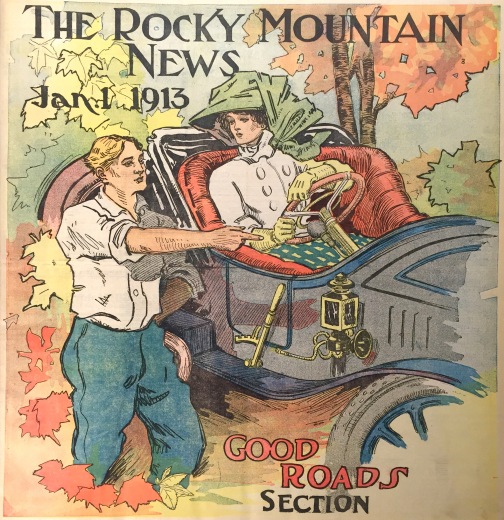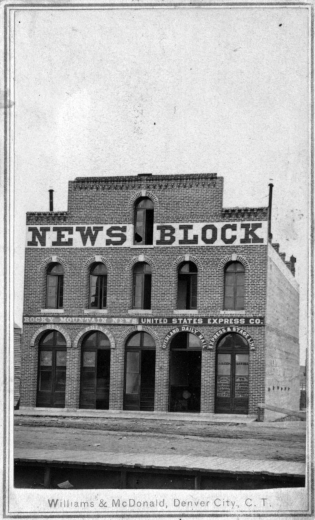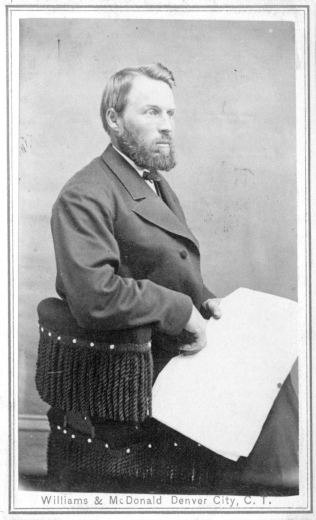View the Rocky Mountain News Photos in our Digital Collections.
The Rocky Mountain News, a newspaper that was a Denver institution for just short of 150 years, was Colorado's oldest newspaper and possibly the longest-running business in the state. Born during the 1859 Colorado Gold Rush, the paper went through many ups and downs, until it finally closed its doors in 2009, just two months shy of its 150th anniversary. For that century and a half, the Rocky Mountain News was to many Coloradans, the "standard," indispensable at breakfast, in the boardroom or at the races, and the news source for generations.
Over the decades, the Denver Public Library has acquired materials from the Rocky, and in 2014 received the paper's entire corpus of digital images to add to our collection. The digital images join our thousands of back issues of actual newspapers bound in volumes, photographic negatives, and comprehensive microfilm of the paper's entire run.
After the paper closed, there was considerable uncertainty about what would be the fate of its vast archives. There was a private equity investor from Texas, Brian Ferguson, who came quite close to acquiring it, but the deal fell through. On June 8, 2009, Scripps-Howard came out with a "jubilant announcement" that it was finalizing an agreement with the Denver Public Library "to ensure responsible stewardship of the storied newspaper's archives and artifacts." The Library "would assume ownership of the Rocky's voluminous archives, including all digital and paper newspaper clipping files," while the Colorado Historical Society [now History Colorado] would receive "such other artifacts as signs, photographs, special editions, artwork and other information that documents the history of the Rocky." Former Special Collections and Archives Department Manager Jim Kroll said that the acquisition included "photos that are in the paper, outtakes, PDFs of the newspaper for the last four years, and streaming video."
As of 2015, Library staff and volunteers have made substantial advances in the organization, cataloging, and storage of the RMN archives, in keeping with our mission of making our collections accessible to our researchers and customers.
April 23, 1859
First issue of William Byers' newspaper, the Rocky Mountain News, comes off the press, beating a rival, the "Cherry Creek Pioneer," by 20 minutes.
September - December 1859
The Rocky moves twice, from the attic of Uncle Dick Wooten's saloon at 1413-15 11th Street to a log cabin at 14th and Market Streets, and then to 13th and Walnut.
August 1860
The Rocky converts from a weekly to a daily newspaper. It moves to a building elevated on stilts in the middle of Cherry Creek, near 13th and Market.
May 1864
The building on stilts is swept away by a flash flood.
1866
After multiple moves, the Rocky settles into a brick building called the "News Block" near 16th and Larimer Streets where it stays until 1887.
July 1870
The Rocky changes from an evening to a morning newspaper.
1878
Byers sells the newspaper to Colorado railroad magnate W.A.H. Loveland, who modernizes with telephones, typesetting machines and wire services.
1887
Under new owners, the paper moves to the southwest corner of 17th and Curtis Streets.
1898
First photographs are reproduced in the Rocky.
1901
First red ink headlines appear in the Rocky, and were used until 1933. The paper moves to 1720 Welton Street.
November, 1926
Scripps Howard Company purchases the Rocky.
April 1942
The Rocky changes format from a broadsheet to a tabloid, under command of the new editor, Jack Foster. This helped revive the paper, which had been on life support in the early 1940s.
June 1952
The Rocky moves from Welton Street to 400 W. Colfax Avenue.
March 1993
The Rocky premieres a newly designed, full color newspaper.
April 2000
The paper wins its first Pulitzer Prize, for photography for its coverage of the 1999 Columbine High School shootings.
May 2000
The Rocky Mountain News and the Denver Post agree to a joint operating agreement that combined advertising, circulation and production departments while preserving two independent newsrooms.
April 1, 2001
The Rocky publishes its last Sunday edition. Under the agreement, the Rocky published a Saturday edition and the Denver Post published the Sunday edition.
April 2003
The Rocky wins a Pulitzer for breaking-news photography for its pictures of Colorado's 2002 wildfire season.
March 2006
Daily circulation: 255,427.
April 2006
Rocky reporter Jim Sheeler and photographer Todd Heisler are awarded Pulitzers for "Final Salute," a report on a Marine major who notifies loved ones of military deaths in the line of duty.
January 23, 2007
The Rocky is redesigned to a smaller, magazine format, with a re-designed masthead and many more color photographs. The re-design was the result of new printing presses, which were able to operate about 25% faster.
December 4, 2008
Scripps announces plans to seek a buyer for the Rocky.
January 29, 2009
Rocky staff and community supporters hold a candlelight vigil to show their support for the newspaper.
February 27, 2009
Final edition of the Rocky Mountain News.
Another part of the Rocky's legacy was the web content that had been developed in the 15 years prior to its closing. Although attempts were made to develop the website and revive it in various forms, first with the "INDenver Times," and then the "Rocky Mountain Independent," these never gained traction and stopped producing content in 2009. Activity at the Rocky's old URL appears to be a simple aggregation of local Denver news source stories. Apparently, the only remnants of the original website are stored in the Internet Archive's Wayback Machine.
From "The First Hundred Years," by Robert L. Perkin:
"The Rocky Mountain News, a journal of some little durability, has survived flood, fire, starvation, and mounted desperadoes with nervous trigger fingers. It has come through half a dozen wars, including the Indian. It has stood off plagues of grasshoppers and, narrowly, two gentlemen of exquisite rapacity named Bonfils and Tammen. Droughts, panics, the Ku Klux Klan have done their worst. Repeal of the Sherman Silver Purchase Act left a deep wound, and the News also has lived out the boycotts of corporations, the ink-tipped lances of Eugene Field, and the hyperbole of flatterers.
Editors of the Rocky Mountain News have been kidnapped, shot at, caned, pistol-whipped, hanged in effigy, and immortalized in stained glass. They have chased redskins, built commonwealths, founded universities, climbed mountains, and been clouted from the rear while walking to work. On one day of scandalous memory an editor was the target of an unrequited mistress armed, naturally, with a pearl-handled revolver." (Perkin, p. 9)
The Colorado Gold Rush of 1858-59 brought hordes of fortune seekers west, and there was a brisk business in writing guidebooks for these adventurers. William N. Byers, from Omaha, who had traveled the Oregon Trail, wrote one of these guides, and in the spring of 1859 put it to his own use, coming to Denver (carrying a printing press with him!) to grab some of the gold that was reportedly just laying around for the taking.
Though he never found gold, he realized that by establishing a newspaper in a city that was itself just getting established, he was literally making history. Those first years, there was a lot of disappointment when people found that after their arduous journey west, the streams were not, as they had imagined, lined with gold. The Rocky Mountain News helped stem the tide of "gobacks" with its reports of real, substantial gold strikes being made daily. "It heaped editorial scorn on the fatuous and the foolhardy and never ceased to admonish all who would travel west to see the elephant that they should arrive well capitalized, prepared for work, and with their heads screwed on tight." (Perkin, p. 16) "From the beginning, the Rocky Mountain News made itself felt as a commanding influence in the life and activities of the new settlements." (Douglas C. McMurtrie quoted by Perkin, p. 16)
Here is one of many fascinating stories from the early days of the Rocky, adapted from Perkin's book:
In 1860, Denver was without a police force, and factions of lawless types, especially the self-styled "Bummers," had established their headquarters in the Criterion saloon, and among many other acts of banditry began stealing turkeys from an Auraria farmer. At the same time, late-comers to the Gold Rush began building houses on the outskirts of town in defiance of the town company, on open land. This combination of problems led to a state of near anarchy in Denver, with lots of shots fired and a general feeling of lawlessness pervading the fledgling metropolis. It finally ended with the cracking of the skull of William McCarty, one of the "Bummer" leaders.
The owner of the Criterion bar, Charley Harrison, who often proudly boasted of all the men he had killed, didn't like the Rocky's editorializing and condemnation of the crime and violence, the July 25, 1860 edition having "cataloged and indexed the bloody record, named the Criterion specifically as the poisonous wellspring of contagion and named Harrison personally as a blackhearted murderer."
On July 31, several Criterion regulars burst into the Rocky's editorial offices and shouting "vile oaths" kidnapped Byers at gunpoint and took him to the Criterion. Harrison, in a moment of apparent sanity, gave Byers a pistol and let him escape out of the back door. The kidnappers went after him again, and now the Rocky's editorial offices became a fort under siege for the next several months. Less than a month later, someone tried unsuccessfully to burn the building down.
Harrison, insulated from justice, began professing friendship and admiration for Byers, giving him a large ring of native gold, inscribed with a Masonic emblem, honoring their shared membership. Eventually, Charley Harrison left Denver never to return.
Thomas Knox, a writer for The Knickerbocker, wrote that:
"Repeated shots have been fired at the News office by indignant 'roughs;' the editors have been assaulted at various times, and on a few occasions their lives have been in great jeopardy... every few weeks a threat of cleaning out the News office was made by its enemies, and the whole corps, from the 'devil' upward, is prepared to resist such a purifying process. The sanctum abounds in guns and revolvers, always at hand; and in squally times each man in the composing room has a 'six-shooter' by the side of his copy. The foreman (Dailey) sports a huge 'navy' at his belt, and the roller-boy is ready to support the honor of the establishment with the weapon of his branch of trade."
Other newspapers came and went, but the Rocky held the course, commanding national attention at times, and winning four Pulitzer prizes in its final ten years. After 150 years of ups and downs, facing the onslaught of electronic media, and like so many other newspapers, large and small, the Rocky finally called it quits.
Here is the first part of the staff's message from the final edition:
"Goodbye, Colorado.
It is with great sadness that we say goodbye to you today. Our time chronicling the life of Denver and Colorado, the nation, and the world, is over. Thousands of men and women have worked at this newspaper since William Byers produced its first edition on the banks of Cherry Creek on April 23, 1859. We speak, we believe, for all of them, when we say that it has been an honor to serve you. To have reached this day, the final edition of the Rocky Mountain News, just 55 days shy of its 150th birthday is painful. We will scatter. And all that will be left are the stories we have told, captured on microfilm or in digital archives, devices unimaginable in those days..."
In addition to the almost 300,000 digital images acquired by the Library, there are also some 2,500 archival containers, about 500 of them of photographs, organized by biography and subject, and which are being processed by volunteers. Special Collections and Archives Librarians are already locating items for researchers from these collections, even as our processing continues.
There are whole subsections dedicated to various newsworthy events, such as political conventions, the Papal visit, and the Columbine shootings. The entire set of digitized images amounts to just over 300,000 images, with about 2,000 of them from the 2008 Democratic National Convention, and about 200 of them related to the Rocky's Pulitzer Prizes.
In addition to the 2009 acquisition, there are almost 150,000 film negatives dating from 1942 to 1969 in our photo vault, which were acquired sometime in the 1970s. These negatives have had some research and labeling, but for the most part, remain un-examined.
Here are high-resolution scans of the first four pages of the First Edition of the Rocky Mountain News. (cropped section shown above).
Searching the new collection of born-digital Rocky Mountain News photographs is more complex than ordinary image searches. The metadata, or basic description, that accompanies every digitized image in our collections documents all the information available for that image. This metadata is also what makes the search function work, and unlike our original core collections upon which we lavished detailed cataloging and metadata, the Rocky Mountain News collection has inconsistent and often scant cataloging or metadata. In some cases, how many we don't know, the dates in the records are not reliable because they are camera stamps which were often not correctly set, especially in the early days of digital photography. If you discover images with no descriptive information, and you have new or additional image information, or if you notice incorrect information, please help us improve the collection by leaving a comment in the comments field.
The different categories of the Rocky Mountain News photographs have different searching quirks that will be useful to keep in mind. Below are explanations for each of these branches of the collection.
Pulitzer Prize collection: Sixty award-winning photographs and one photo essay live inside this relatively small collection, along with images directly relating to them. You'll have the most success searching by photographer in the Creator field, or by keyword using the Title, Description, or Keywords fields. Images related to a particular Pulitzer subset can be found by searching by specific year. For example, "2003 Pulitzer" (the prize was awarded in 2003) will bring up all Pulitzer images surrounding the 2002 forest fires as well as the storyboards the newspaper used to submit their nomination for the prize. All stand-alone prize-winning photographs will have a description that starts with: "PULITZER PRIZE PHOTOGRAPH." Alternatively, you can go right to the photo galleries for Columbine: Images of Tragedy, Colorado on Fire, and Final Salute.
Democratic National Convention collection: In 2008 Denver hosted the Democratic National Convention, where Barack Obama became the party's nominee for President. Enjoy browsing through more than 2,000 images both public and candid taken from August 25-28. Some images in this collection are still lacking titles, so we recommend that you use "Advanced Search," and search for keywords in "All Fields." Or if you know a particular speech happened on a particular day, try a date search.
Rocky Mountain News Photograph collection: More than 300,000 images taken from 1999 to 2009 live in this primary set of born-digital photography. From the dramatic to the mundane, this amazing collection makes for great browsing. You might find information in multiple places, so it's best to use "Advanced Search," and search for keywords in "All Fields." You'll also want to approach your search from multiple angles to get more complete search results.
The Special Collections and Archives Department of the Denver Public Library has extensive holdings of the Rocky Mountain News in various formats. We have actual printed newspapers bound in volumes running from January 1865 to December 1941. Our microfilm collection covers dates from April 1859 to February 2009. Indexing is available in the form of the General Index, a volunteer-compiled index of multiple Western publications, including the Rocky Mountain News, which is now online. From 1992 on, the Rocky is now available in a searchable electronic format available online to Denver Public Library card holders.
We have a myriad of books, special editions, calendars, announcements, and ephemera that originated with the Rocky Mountain News. Here is a selection from the hundreds of search results in our database for the term "Rocky Mountain News."
- "The Rocky Mountain News, 125th Anniversary, 1859-1984, Souvenir Edition of the RMN, April 22, 1984
- Rocky Mountain News Ride Guide II - 36 New Colorado Bike Rides from the Weekly Column
- Items About Denver from the Rocky Mountain News, by Nolie Mumie
- Old Printing Office of the Rocky Mountain News, art original by Anne Daily
- Denver Legislative District Map, the Rocky Mountain News
- The Official Colorado Rockies1993 Inaugural Scrapbook, the Rocky Mountain News
- The First Hundred Years: An Informal History of Denver and the Rocky Mountain News, by Robert Perkin
- High-resolution scans of the first four pages of the First Edition of the Rocky Mountain News.
- Blue Ribbon Rivers of the Rockies, Rocky Mountain News Fishing Guide to the West's Best Streams, by Ed Dentry
- Heroes, Villains, Dames & Disasters, 150 Years of Front Page Stories from the Rocky Mountain News
- Recipe Please: Favorite Recipes from Colorado Restaurants, from the Popular Column by Marty Meitus
- Bird's Eye View of Denver, Rocky Mountain News, 1887
- The Colorado Smart Shopper, Janet Simons, 1995
- William N. Byers Family Papers
- Frances Melrose Papers
- Eugene Cervi Papers
We also have extensive indexing to Rocky Mountain News birth, marriage, death, funeral and burial notices.
If you have any questions, comments or suggestions about the Rocky Mountain News digital collections, please contact us on our contact form, choosing Rocky Mountain News from the dropdown subject menu.





